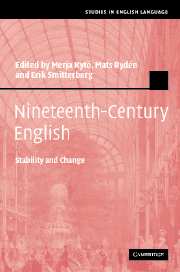Book contents
- Frontmatter
- Contents
- List of plates
- List of figures
- List of tables
- List of contributors
- Acknowledgements
- Introduction: Exploring nineteenth-century English – past and present perspectives
- 1 Modifiers describing women and men in nineteenth-century English
- 2 Words in English Record Office documents of the early 1800s
- 3 The subjunctive in adverbial clauses in nineteenth-century English
- 4 The passive in nineteenth-century scientific writing
- 5 Relativizers in nineteenth-century English
- 6 Anaphoric reference in the nineteenth century: that/those + of constructions
- 7 Adjective comparison in nineteenth-century English
- 8 Nonfinite complement clauses in the nineteenth century: the case of remember
- 9 The in -ing construction in British English, 1800–2000
- 10 Partitive constructions in nineteenth-century English
- Appendix
- References
- Name index
- Subject index
Introduction: Exploring nineteenth-century English – past and present perspectives
Published online by Cambridge University Press: 22 September 2009
- Frontmatter
- Contents
- List of plates
- List of figures
- List of tables
- List of contributors
- Acknowledgements
- Introduction: Exploring nineteenth-century English – past and present perspectives
- 1 Modifiers describing women and men in nineteenth-century English
- 2 Words in English Record Office documents of the early 1800s
- 3 The subjunctive in adverbial clauses in nineteenth-century English
- 4 The passive in nineteenth-century scientific writing
- 5 Relativizers in nineteenth-century English
- 6 Anaphoric reference in the nineteenth century: that/those + of constructions
- 7 Adjective comparison in nineteenth-century English
- 8 Nonfinite complement clauses in the nineteenth century: the case of remember
- 9 The in -ing construction in British English, 1800–2000
- 10 Partitive constructions in nineteenth-century English
- Appendix
- References
- Name index
- Subject index
Summary
Introduction
The structure and use of the English language has been studied, from both synchronic and diachronic perspectives, since the sixteenth century. The result is that, today, English is probably the best researched language in the world. But the field is as unlimited as language itself, and therefore there will always be gaps in our knowledge of the historical development of English as well as of its time-bound, or synchronic, uses. In this respect, Late Modern English (1700–1950) has been given less scholarly attention than other periods in the history of English. This is particularly true of the nineteenth century and the first half of the twentieth century. The main reason why this period has been relatively ignored by historical linguists is presumably that at first sight it appears little different from Present-day English, resulting in the view that not much has happened in the language in the course of the last 200 years or so (for discussion, see Romaine 1998a: 7; Rydén 1979: 34; Rydén and Brorström 1987: 9). As Beal (2004: xi) points out, until the millennium the nineteenth century was also ‘the last century’ from a contemporary scholar's perspective. The recency of nineteenth-century developments may have added to the view that the language of this period was not an interesting topic for historical research, where the ‘antiquity’ of the English language has often been in focus.
However, knowledge of the immediate or recent past is often crucial for our understanding of the language of the present day.
- Type
- Chapter
- Information
- Nineteenth-Century EnglishStability and Change, pp. 1 - 16Publisher: Cambridge University PressPrint publication year: 2006
- 8
- Cited by

